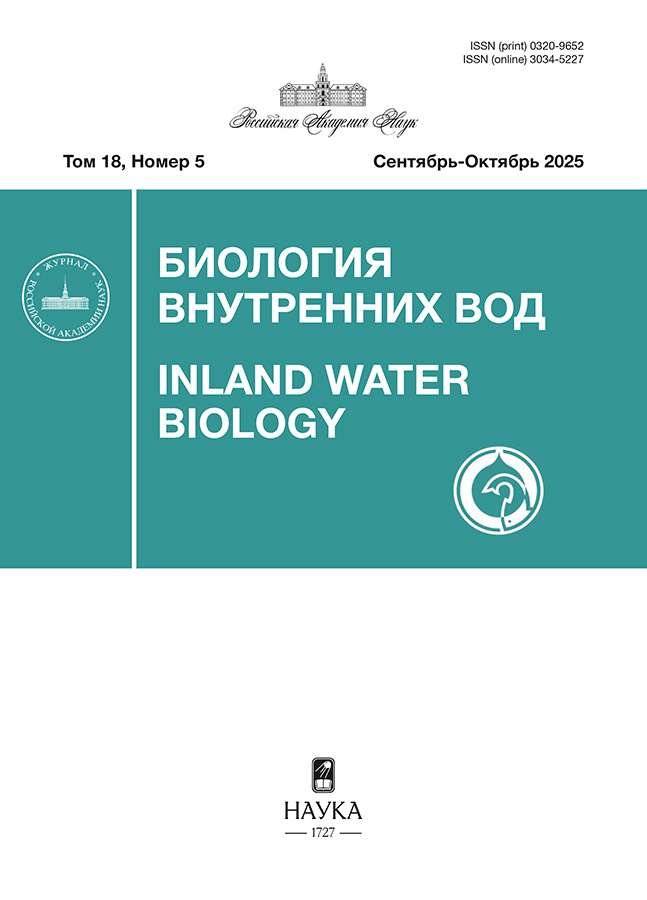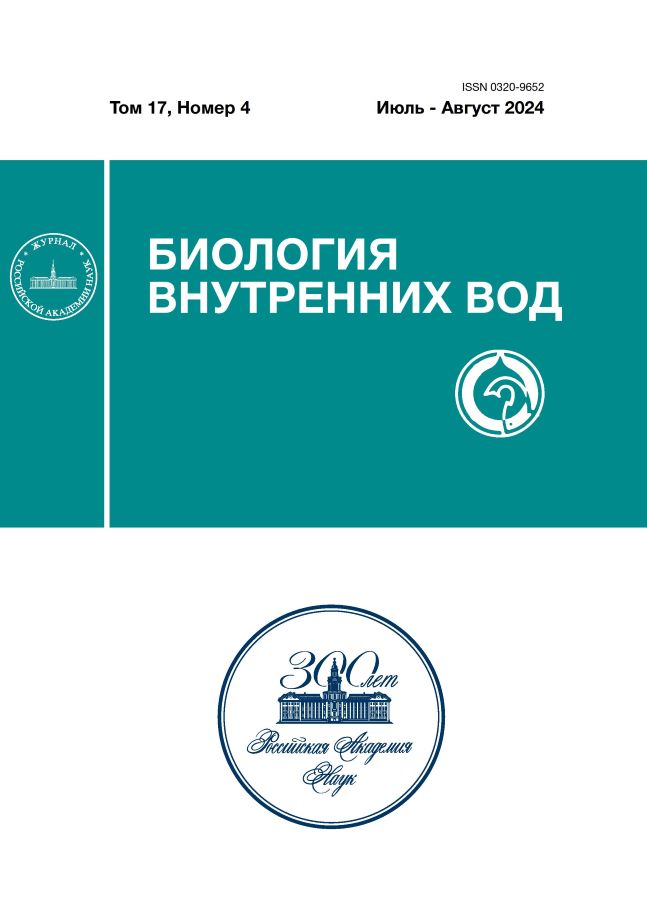Комплекс стероидных гормонов у беспозвоночных гидробионтов
- Авторы: Никитина С.М.1, Полунина Ю.Ю.1,2
-
Учреждения:
- Балтийский Федеральный университет им. И. Канта
- Институт океанологии им. П.П. Ширшова Российской академии наук
- Выпуск: Том 17, № 4 (2024)
- Страницы: 648-660
- Раздел: ЭКОЛОГИЧЕСКАЯ ФИЗИОЛОГИЯ И БИОХИМИЯ ГИДРОБИОНТОВ
- URL: https://jdigitaldiagnostics.com/0320-9652/article/view/670100
- DOI: https://doi.org/10.31857/S0320965224040138
- EDN: https://elibrary.ru/YIYLIO
- ID: 670100
Цитировать
Полный текст
Аннотация
Экспериментально выявлено наличие комплекса биологически активных стероидных соединений (БАСС) – гидрокортизона, кортикостерона, прогестерона, тестостерона и эстрогенов (гормонов позвоночных) у беспозвоночных гидробионтов разного филогенетического уровня. Зафиксированы особенности количественного содержания БАСС в разных органах и тканях гидробионтов и их изменения на разных стадиях развития. Уровень БАСС в организмах или их органах во многом обусловлен собственным стероидогенезом, но в то же время организмы могут накапливать экзогенные стероидные соединения. Показана адаптивная роль БАСС у некоторых беспозвоночных в изменяющихся условиях водной среды. Сходство концентрации стероидных соединений в разных группах бионтов свидетельствует о некой “физиологической константе” этого комплекса соединений у всех организмов.
Ключевые слова
Полный текст
Об авторах
С. М. Никитина
Балтийский Федеральный университет им. И. Канта
Email: swetmih@gmail.com
Россия, Калининград
Ю. Ю. Полунина
Балтийский Федеральный университет им. И. Канта; Институт океанологии им. П.П. Ширшова Российской академии наук
Автор, ответственный за переписку.
Email: jul_polunina@mail.ru
Россия, Калининград; Москва
Список литературы
- Ганжа Е.В., Павлов Е.Д. 2019. Суточная динамика тиреоидных и половых стероидных гормонов в крови молоди радужной форели // Биология внутр. вод. № 3. С. 80. https://doi.org/10.1134/S0320965219040065
- Кунин Е.В. 2014. Логика случая. О природе и происхождении биологической эволюции. М.: Центрполиграф.
- Майстренко Н.А., Колесников Г.С., Вавилов А.В. и др. 1999. Уровень секреции стероидов в отдаленные сроки после оперативного устранения эндогенного гиперкортицизма // Клиническая и экспериментальная хирургия. № 1. С. 151.
- Кудикина Н.П. 2011. Влияние гормональных соединений на эмбриогенез прудовика Lymnaea stagnalis (Lam., 1799) // Онтогенез. Т. 42. № 3. С. 213.
- Никитина С.М. и др. 1977а. Гидрокортизон и кортикостерон в телах и тканях некоторых беспозвоночных животных // Вестн. Академии наук БССР. Сер. Биол. науки. № 2. С. 108.
- Никитина С.М. и др. 1977б. Препаративное выделение прогестерона, тестостерона и эстрогенов из тканей морских беспозвоночных // Журн. эволюционной биохимии и физиологии. № 4. С. 443.
- Никитина С.М. 1982. Стероидные гормоны беспозвоночных животных. Л.: Ленинград. гос. ун-т.
- Никитина С.М. 2019. Биологически активные стероидные соединения беспозвоночных животных. Калининград: БФУ им. И. Канта.
- Никитина С.М., Чибисова Н.В. 2011. Динамика глюкокортикоидов в онтогенезе длиннопалого речного рака (Astacus leptodactylus Esch) // Онтогенез. Т. 42. № 3. С. 232.
- Орбели Л.А. 1961. Основные задачи и методы эволюционной физиологии. Избранные труды. М.: АН СССР. Т. 1. С. 59.
- Полунина Ю.Ю., Никитина С.М. 2014. Влияние стероидных соединений на темпы роста и плодовитость ветвистоусых ракообразных (Cladocera) // Вода: химия и экология. № 6. C. 68.
- Романенко В.Н. 2013. Основы сравнительной физиологии беспозвоночных: уч. пособие. Томск: Томск. гос. ун-т.
- Уголев А.М. 1987. Естественные технологии биологических систем. Л.: Наука.
- Уотсон Дж. 1978. Молекулярная биология гена. М.: Мир.
- Хотимченко Ю.С., Деридович И.И., Мотавкин П.А. 1993. Биология размножения и регуляция гаметогенеза и нереста у иглокожих. М.: Наука.
- Эволюционная физиология. 1983. Л.: Наука. Ч. 1.
- Bing-hui Z., Li-hui A., Chang H. et al. 2014. Evidence for the presence of sex steroid hormones in Zhikong scallop, Chlamys farreri // J. Steroid Biochem. V. 143. P. 199. https://doi.org/10.1016/j.jsbmb.2014.03.002
- Cenovic M.G. 1954. Analyse de l´effect stimulant des gonadotrophines de Mammiferes sur la reproduction des daphnies // C. Acad. Sci. Paris. V. 239. P. 363.
- Dancasiu M., Istrati F. 1958. Identification of estrogenic hormone in Artemia salina // Studii si cercetari de endocrinology. V. 2. Annl. 1X. P. 18.
- Dorfman R., Ungar F. 1965. Metabolism of Steroid Hormones. N.Y.: Acad. Press.
- Fodor I., Urbán P., Scott A.P., Pirger Z.A 2020. А critical evaluation of some of the recent so-called ‘evidence’for the involvement of vertebrate-type sex steroids in the reproduction of mollusks // Mol. Cell. Endocrinol. V. 516. P. 110949. https://doi.org/10.1016/j.mce.2020.110949
- Fodor I., Pirger Z. 2022. From dark to light-an overview of over 70 years of endocrine disruption research on marine mollusks // Frontiers in Endocrinol. V. 13. P. 903575. https://doi.org/10.3389/fendo.2022.903575
- Giulia M.G., Muttenthaler M., Harpsøe K. et al. 2017. Development of a human vasopressin V1a-receptor antagonist from an evolutionary-related insect neuropeptide // Sci. Reports. V. 7. P. 41002. https://doi.org/10.1038/srep41002
- Ketata I., Guermazi F., Rebai T. et al. 2007. Variation of steroid concentrations during the reproductive cycle of the clam Ruditapes decussatus: A one year study in the gulf of Gabès area // J. Comp. Biochem. V. 147. P. 424. https://doi.org/10.1016/j.cbpa.2007.01.017
- Hartenstein V. 2006. The neuroendocrine system of invertebrates: a developmental and evolutionary perspective // J. Endocrinol. № 190(3). P. 555. https://joe.bioscientifica.com/view/journals/joe/190/3/1900555.xml
- Kulkarni A.B., Nagabhushanam R.A., Joshi P.K. 1981. Neuroendocrine regulation of reproductionin the marine female prawn, Parapenaeopsis hardwickii (Miers) // Indian. J. Mar. Sci. V. 10. № 4. P. 350.
- Lafont R., Mathieu M. 2007. Steroids in aquatic invertebrates // Ecotoxicology. № 16. P. 109. https://doi.org/10.1007/s10646-006-0113-1
- Mellon S., Griffin L. 2002. Neurosteroids: biochemistry and clinical significance // Trends Endocrinol. Metab. V. 13(1). P. 35. https://doi.org/10.1016/s1043-2760(01)00503-3
- Mori K. 1968. Effect of steroid on oyster. 1. Activation of respiration in gonad by estradiol-17b // Bull. Japan. Soc. Sci. Fish. V. 34. № 10. P. 915.
- Hara S.C.M., Corner E.D.S., Kilvington C.C. 1978. On the nutrition and metabolism of zooplankton XII. Measurements by radioimmunoassay of the levels of a steroid in Calanus // J. Mar. Biol. Assoc. V. 58. № 3. P. 597.
- Scott A.P. 2018. Is there any value in measuring vertebrate steroids in invertebrates? // Gen. and Comp. Endocrinol. V. 265. P. 77. https://doi.org/10.1016/j.ygcen.2018.04.005
- Takeda N. 1979. Induction of egg-laying by steroid hormones in slugs // Comp. Biochem. and Physiol. V. 62. № 2. P. 273.
- Taylor J., McCann K., Ross A. 2020. Binding affinities of oxytocin, vasopressin, and Manning 14 Compound at oxytocin and V1a receptors in Syrian hamster brains // bioRxiv preprint https://doi.org/10.1101/2020.03.18.995894
- Teshima S.I., Fleming R., Gaffney J. et al. 1977. Studies on steroid metabolism in echinoderm Asterias rubens // Mar. Natur. Prod. Chem. Nato Conference Ser. V. 1. Boston: Springer. P. 133. https://doi.org/10.1007/978-1-4684-0802-7_11
- Thiboutot D., Jabara S., McAllister J.M. et al. 2003. Human skin is a steroidogenic tissue: steroidogenic enzymes and cofactors are expressed in epidermis, normal sebocytes, and an immortalized sebocyte cell line (SEB-1) // J. Invest. Dermatol. V. 120(6). P. 905. https://doi.org/10.1046/j.1523-1747.2003.12244.x
- Twan W.-H., Wu H.-F., Hwang J.-S. et al. 2005. Corals have already evolved the vertebrate type hormone system in the sexual reproduction // Fish Physiol. and Biochem. V. 31. № 2–3. P. 111. https://doi.org/10.1007/s10695-006-7591-1
- Twan W.-H., Hwang J.-S., Lee Y.-H. 2006. Hormones and reproduction in scleractinian corals // Comp. Biochem. and Physiol. Part A. Mol. and Integr. Physiol. V. 144. P. 247. https://doi.org/10.1016/j.cbpa.2006.01.011
Дополнительные файлы














